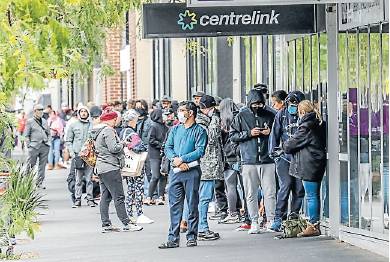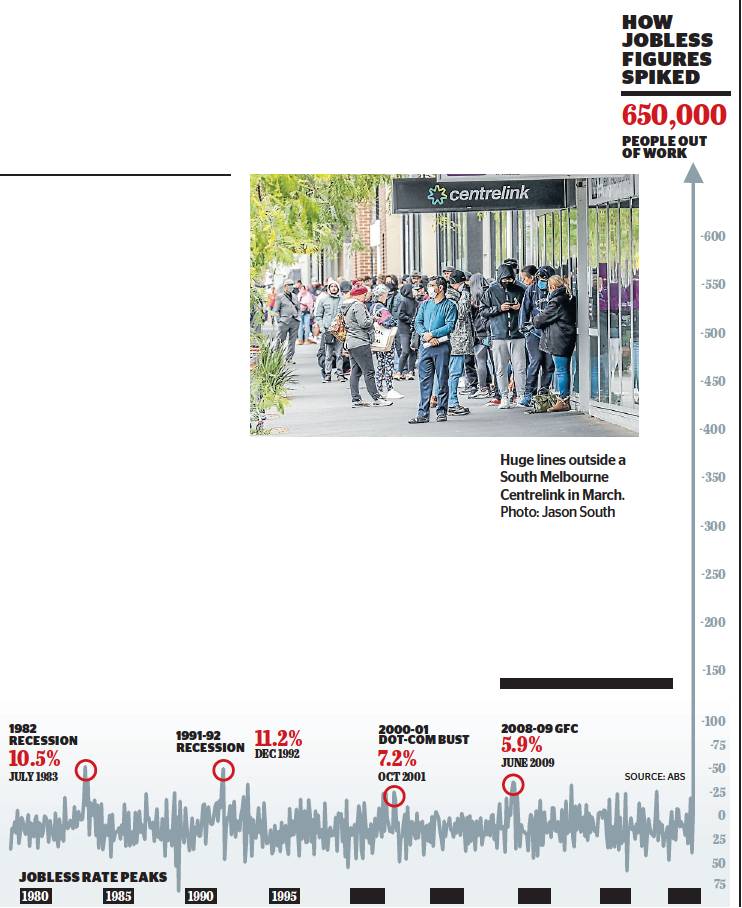Record job losses ‘devastate’ nation
Shane Wright
Senior economics correspondent
Australians are being told to prepare for even more financial pain after the biggest collapse in the number of people with jobs and warnings the house construction sector faces a disaster that will drag down the economy into next year.
Almost 600,000 people left the workforce in April, the Australian Bureau of Statistics revealed yesterday, the single largest fall in employment in a month, which wiped away two years of jobs growth.
While official unemployment rose by a full percentage point to 6.2 per cent, it would have been much worse but for the collapse in the number of people active in the jobs market.
The bureau said the jobless rate without a 2.4-percentage-point drop in the participation rate would have been 9.6 per cent. Once the proportion of people working reduced hours is taken into account, the underemployment rate hit an alltime high of 19.9 per cent. The Morrison government’s $130 billion JobKeeper program prevented the headline jobless rate being even worse, as millions of people barred from working are being paid through the wage subsidy scheme.
The bureau estimates 2.7 million people, or almost 20 per cent of the working population, either lost their job or had their hours cut for economic reasons through the month.
Prime Minister Scott Morrison said the figures, which covered the period when the economy was effectively shut down to prevent the spread of the coronavirus, highlighted the challenge facing many ordinary Australians.
‘‘This is a tough day for Australia. A very tough day,’’ he said.
‘‘Almost 600,000 jobs have been lost. Every one of them devastating for those Australians, for their families, for their communities.’’
Total unemployment lifted by a less-than-expected 104,500, mostly due to the large number of people who abandoned the jobs market altogether. At 823,300, the number of unemployed Australians is at its highest level since September 1994.
Of the 13.2 million Australians in the national workforce, 6 million are being supported by taxpayers via JobKeeper, while another 1.6 million are on JobSeeker.
Women have borne the brunt of the response to the coronavirus.
Hours worked have dropped by almost 10 per cent over the past two months, 3.5 times more than the previous worst fall in mid-1979.
Paid hours worked by women crashed by 11.5 per cent while for men the fall was 7.5 per cent.
Female underemployment is now at 14.8 per cent, while for men it is 12.9 per cent. Opposition Leader Anthony Albanese said the 600,000 drop in employment was a devastating figure, arguing it was worse than it might have been because of restrictions around JobKeeper.
‘‘When we look at the JobKeeper program, the government is still leaving people behind, particularly the most vulnerable. Our casual employees, people in whole sectors like the arts and entertainment sector, aren’t getting the support that they need,’’ he said.
Mr Morrison said for young people – of whom more than 37 per cent are either out of work or are surviving on reduced hours – the situation was something beyond imagination. But it is likely to get worse. The Housing Industry Association said new home sales were now at their lowest level on record, with 30 per cent of buildings being cancelled through April.
Association chief economist Tim Reardon said the number of homes expected to be built had been cut in half, which will affect hundreds of thousands of jobs and the broader economy. ‘‘Even the removal of all COVID-19 restrictions will not prevent a material deterioration in work and employment in the home building sector in the second half of 2020 and into 2021,’’ he said.
‘‘Unlike the reopening of other sectors, the lead time for the home building pipeline is six to nine months, so even if the economy restarts on July 1 the supply of work in residential building will continue to decline into 2021.’’
NAB economist Kaixin Owyong said the figures showed the nation was facing a big reduction in income. ‘‘The data suggest that the corresponding hit to household income is extremely large, which will limit the bounce-back in spending and activity as the economy recovers,’’ she said.

